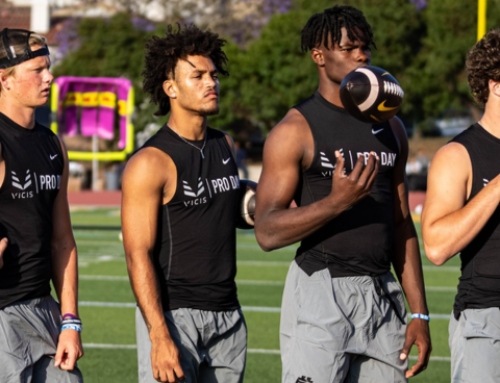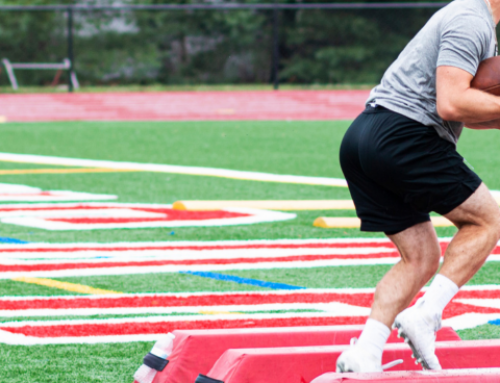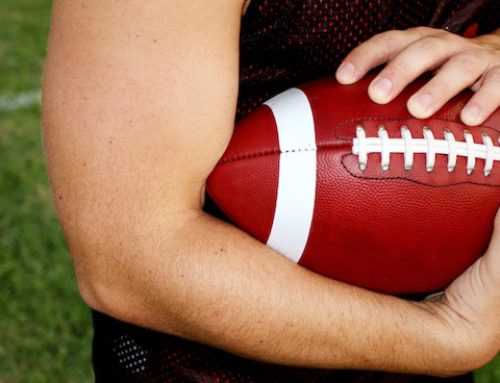A Field Guide to Weird Looking Weightlifting Bars
It’s usually propped up in a broom closet with the cleaning supplies. If it’s not there, I can sometimes find it near a power rack. Most guys only look at it long enough to ensure they don’t trip on their way to the calf raise machine. And no, it’s not the PVC pipe newbies use to practice their form.
I’m talking about the safety squat bar.
It’s that funky looking contraption with handles and a neck brace built in to the center. When I use it, the meatheads in the gym usually look at me like I whipped out a jazzercise DVD. I get the same looks when I Bench Press with a football bar or Deadlift with a trap bar.
Thing is, those specialty bars train tried-and-true movements like the Bench Press, Deadlift and Squat, but with a twist. The hope is that a slightly different stimulus gives me an edge when I return to the meat-and-potatoes straight-bar version of the lift.
More specialty weightlifting bars like the ones below are creeping into gyms nationwide. If you’re not familiar with them, you might brush them off as gimmicks. But for those with the knowledge, these seldom-used tools can be powerful pistons in your training wheelhouse. Here’s a snapshot of what they are and how they can challenge you in safe and effective ways.
Trap Bar
“The trap bar is a great introduction into the Deadlift because a lot of people lack the hip mobility required to get into proper position for a Straight Bar Deadlift,” says Steve Grosso, CSCS, and former junior American record holder in the Squat. “A trap bar lends itself to almost being a hybrid between a Squat and a Deadlift, to kind of transition to get into that pulling motion.” If you’re not a beginner, Grosso says that subtle differences in the mechanics of the lift could be the nudge you need to increase your strength. “The fact that it is a hybrid motion will allow you to develop different musculature than just doing your traditional Deadlift all the time,” he says.
Try This: To blast your grip, wrap the handles with towels and walk with the bar as far as you can in one direction. Once you’ve regained feeling in your forearms, head back the way you came.
Football Bar
“A football bar is a fantastic option for anyone who has shoulder issues, because it’s going to limit your shoulder’s external rotation,” says Grosso. “You can use it for any pressing variation you want to do—Bench, Incline Bench, Overhead Press, anything like that. It’s going to take a ton of stress off your shoulders.” It’s also useful if you’re not injured in that, similar to the trap bar, it provides your body with a different stimulus to prod your muscles into growing. In addition to your pressing movements, you can also use it to perform Upright Rows or Bicep Curls with a neutral grip.
Try This: Replace your Straight Bar Bench Press with the wide grip on the football bar for a less taxing movement on your shoulders.
Farmer’s Walk Bars
“Loaded carries [like the Farmer’s Walk], in my opinion, are the best form of core training,” says Grosso. “They have that reactive component—the weight is moving around, you have to stabilize your trunk. I recommend them for any athlete. It goes out of the norm of ‘I need to do abs’ for my core. This is real, functional core work. In life you have to pick up heavy stuff and walk with it.” The thicker handles that legitimate Farmer’s Walk bars have also challenge your grip in a way that traditional dumbbells and barbells simply cannot.
Try This: Load the Farmer’s Walk bar with a weight you can comfortably handle, but in smaller increments. For example, if you’re used to loading 45-pound plates on each side of the bar, load up four ten pound plates and one five pound plate. Walk as far as you can, then strip a five or ten off each side when your grip gives out. Continue dropping weight until you can’t hold the bar any longer.
Cambered Squat Bar
The cambered squat bar looks almost like a welder’s experiment gone wrong, but you can’t argue with the training results it delivers for athletes. “I can’t say enough good things about the cambered bar,” says Grosso. “The core involvement is crazy. You have reactive core development, because the weights are moving. Whatever [sport] you’re training for, [reactive core development] is insanely important. Any movement you can do with a cambered bar I suggest doing.”
Try This: Load the cambered bar with an appreciable amount of weight, then hang chains or kettlebells off the end of the sleeves. Walk from squat rack to squat rack for a killer core workout. Make sure you’ve got a place to dump the bar if it becomes too challenging.
Axle Bar
Also known as a “fat bar,” the axle bar challenges your grip by thickening the parts of the bar you grab when you press and pull. “There is not an athlete in the world who needs less grip strength,” says Grosso. “When it comes to pressing movements, I like it because it forces you to get your arms into the proper position. With a straight bar you can allow your wrists to cock back. If you’re doing overhead presses with an axle bar, it forces your elbows directly under the bar. It’s important to get your elbows under the bar in any pressing movement.”
Try This: Hang Clean and Press with the axle bar for reps. The Clean will challenge your grip while the Press will force you into proper mechanics.
Safety Squat Bar
“With the safety squat bar, there are handles right at your shoulders so you don’t have to externally rotate to hold the bar,” says Grosso. “That’s what kind of originated the safety squat bar. If you blow out your rotator cuff, it’s a way for you to still be able to squat.” Even if you don’t have shoulder problems, the safety squat bar is a great way to take stress off of your shoulders when squatting. Grosso says this bar is fantastic for athletes looking to minimize wear and tear on their rotator cuff (like a pitcher) while still squatting.
Try This: Front Squats with the safety squat bar. Unrack the bar with the neck brace nestled under your chin and the handles resting on your shoulders, then squat. The setup will be fairly similar to a Zercher Squat. “Safety Bar Front Squats are fantastic,” says Grosso. “They are really posturally intensive. It’s going to do a ton for your upper back, as well as your entire posterior chain.”
Log Bar
“I actually wouldn’t recommend it for athletes [who perform moves] overhead,” says Grosso. “This is more a football-specific move, or a move for someone who needs raw pressing power. With a regular straight bar, the path of the bar is easily predicted. With a log press it’s not so predictable, so it comes down to more brute strength.”
Try This: In your off-season, switch out your Straight Bar Military Presses with Log Presses to build raw power.
Bamboo Bar
This tool is rarely seen except in the most hardcore gyms, but if you’ve got one at your disposal, count yourself lucky. The bamboo bar is a great way to add strength without damaging your joints. “The bar itself probably only weighs ten or 15 pounds because it’s made out of bamboo,” says Grosso. “It has sleeves with grooves so you can hang kettle bells or weights off of it [with bands]. By hanging the kettle bells [or weight plates] off of it, you add a huge amount of stability demand—you’re essentially able to get more muscle activation out of less weight.”
Try This: Set up a bamboo bar on a bench rack and load approximately 30 percent of your one-rep max to the bar with kettlebells hanging off the sleeves with bands. “Let’s say you can do the bamboo bar plus two twenty-pound kettlebells,” says Grosso. “That’s going to be equivalent of benching 185 on a regular bar, because the bamboo bar shakes and forces you to stabilize so much.”
RECOMMENDED FOR YOU
MOST POPULAR
A Field Guide to Weird Looking Weightlifting Bars
It’s usually propped up in a broom closet with the cleaning supplies. If it’s not there, I can sometimes find it near a power rack. Most guys only look at it long enough to ensure they don’t trip on their way to the calf raise machine. And no, it’s not the PVC pipe newbies use to practice their form.
I’m talking about the safety squat bar.
It’s that funky looking contraption with handles and a neck brace built in to the center. When I use it, the meatheads in the gym usually look at me like I whipped out a jazzercise DVD. I get the same looks when I Bench Press with a football bar or Deadlift with a trap bar.
Thing is, those specialty bars train tried-and-true movements like the Bench Press, Deadlift and Squat, but with a twist. The hope is that a slightly different stimulus gives me an edge when I return to the meat-and-potatoes straight-bar version of the lift.
More specialty weightlifting bars like the ones below are creeping into gyms nationwide. If you’re not familiar with them, you might brush them off as gimmicks. But for those with the knowledge, these seldom-used tools can be powerful pistons in your training wheelhouse. Here’s a snapshot of what they are and how they can challenge you in safe and effective ways.
Trap Bar
“The trap bar is a great introduction into the Deadlift because a lot of people lack the hip mobility required to get into proper position for a Straight Bar Deadlift,” says Steve Grosso, CSCS, and former junior American record holder in the Squat. “A trap bar lends itself to almost being a hybrid between a Squat and a Deadlift, to kind of transition to get into that pulling motion.” If you’re not a beginner, Grosso says that subtle differences in the mechanics of the lift could be the nudge you need to increase your strength. “The fact that it is a hybrid motion will allow you to develop different musculature than just doing your traditional Deadlift all the time,” he says.
Try This: To blast your grip, wrap the handles with towels and walk with the bar as far as you can in one direction. Once you’ve regained feeling in your forearms, head back the way you came.
Football Bar
“A football bar is a fantastic option for anyone who has shoulder issues, because it’s going to limit your shoulder’s external rotation,” says Grosso. “You can use it for any pressing variation you want to do—Bench, Incline Bench, Overhead Press, anything like that. It’s going to take a ton of stress off your shoulders.” It’s also useful if you’re not injured in that, similar to the trap bar, it provides your body with a different stimulus to prod your muscles into growing. In addition to your pressing movements, you can also use it to perform Upright Rows or Bicep Curls with a neutral grip.
Try This: Replace your Straight Bar Bench Press with the wide grip on the football bar for a less taxing movement on your shoulders.
Farmer’s Walk Bars
“Loaded carries [like the Farmer’s Walk], in my opinion, are the best form of core training,” says Grosso. “They have that reactive component—the weight is moving around, you have to stabilize your trunk. I recommend them for any athlete. It goes out of the norm of ‘I need to do abs’ for my core. This is real, functional core work. In life you have to pick up heavy stuff and walk with it.” The thicker handles that legitimate Farmer’s Walk bars have also challenge your grip in a way that traditional dumbbells and barbells simply cannot.
Try This: Load the Farmer’s Walk bar with a weight you can comfortably handle, but in smaller increments. For example, if you’re used to loading 45-pound plates on each side of the bar, load up four ten pound plates and one five pound plate. Walk as far as you can, then strip a five or ten off each side when your grip gives out. Continue dropping weight until you can’t hold the bar any longer.
Cambered Squat Bar
The cambered squat bar looks almost like a welder’s experiment gone wrong, but you can’t argue with the training results it delivers for athletes. “I can’t say enough good things about the cambered bar,” says Grosso. “The core involvement is crazy. You have reactive core development, because the weights are moving. Whatever [sport] you’re training for, [reactive core development] is insanely important. Any movement you can do with a cambered bar I suggest doing.”
Try This: Load the cambered bar with an appreciable amount of weight, then hang chains or kettlebells off the end of the sleeves. Walk from squat rack to squat rack for a killer core workout. Make sure you’ve got a place to dump the bar if it becomes too challenging.
Axle Bar
Also known as a “fat bar,” the axle bar challenges your grip by thickening the parts of the bar you grab when you press and pull. “There is not an athlete in the world who needs less grip strength,” says Grosso. “When it comes to pressing movements, I like it because it forces you to get your arms into the proper position. With a straight bar you can allow your wrists to cock back. If you’re doing overhead presses with an axle bar, it forces your elbows directly under the bar. It’s important to get your elbows under the bar in any pressing movement.”
Try This: Hang Clean and Press with the axle bar for reps. The Clean will challenge your grip while the Press will force you into proper mechanics.
Safety Squat Bar
“With the safety squat bar, there are handles right at your shoulders so you don’t have to externally rotate to hold the bar,” says Grosso. “That’s what kind of originated the safety squat bar. If you blow out your rotator cuff, it’s a way for you to still be able to squat.” Even if you don’t have shoulder problems, the safety squat bar is a great way to take stress off of your shoulders when squatting. Grosso says this bar is fantastic for athletes looking to minimize wear and tear on their rotator cuff (like a pitcher) while still squatting.
Try This: Front Squats with the safety squat bar. Unrack the bar with the neck brace nestled under your chin and the handles resting on your shoulders, then squat. The setup will be fairly similar to a Zercher Squat. “Safety Bar Front Squats are fantastic,” says Grosso. “They are really posturally intensive. It’s going to do a ton for your upper back, as well as your entire posterior chain.”
Log Bar
“I actually wouldn’t recommend it for athletes [who perform moves] overhead,” says Grosso. “This is more a football-specific move, or a move for someone who needs raw pressing power. With a regular straight bar, the path of the bar is easily predicted. With a log press it’s not so predictable, so it comes down to more brute strength.”
Try This: In your off-season, switch out your Straight Bar Military Presses with Log Presses to build raw power.
Bamboo Bar
This tool is rarely seen except in the most hardcore gyms, but if you’ve got one at your disposal, count yourself lucky. The bamboo bar is a great way to add strength without damaging your joints. “The bar itself probably only weighs ten or 15 pounds because it’s made out of bamboo,” says Grosso. “It has sleeves with grooves so you can hang kettle bells or weights off of it [with bands]. By hanging the kettle bells [or weight plates] off of it, you add a huge amount of stability demand—you’re essentially able to get more muscle activation out of less weight.”
Try This: Set up a bamboo bar on a bench rack and load approximately 30 percent of your one-rep max to the bar with kettlebells hanging off the sleeves with bands. “Let’s say you can do the bamboo bar plus two twenty-pound kettlebells,” says Grosso. “That’s going to be equivalent of benching 185 on a regular bar, because the bamboo bar shakes and forces you to stabilize so much.”



















